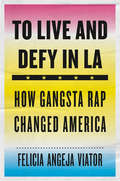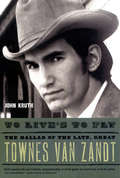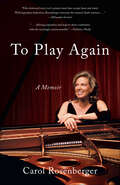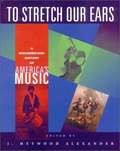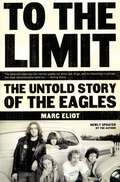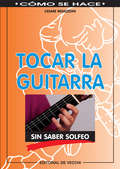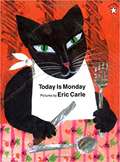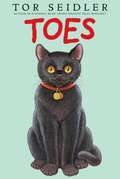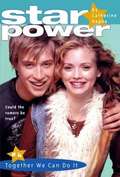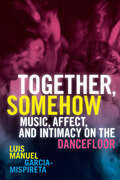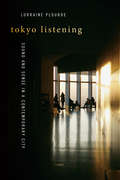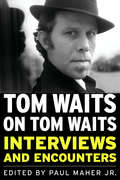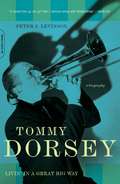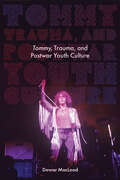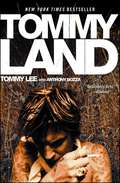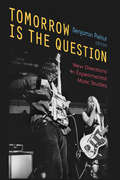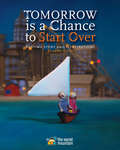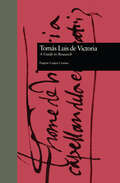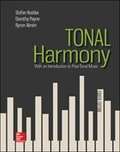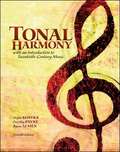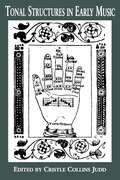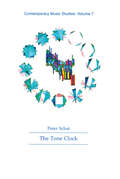- Table View
- List View
To Live and Defy in LA: How Gangsta Rap Changed America
by Felicia Angeja ViatorIn its early days, rap was understood as the poetry of the “inner city,” which usually meant New York. Few expected anything as hard-edged as gangsta rap to emerge from Los Angeles, home of surf and sun. Felicia Viator tells the story of LA’s self-styled “ghetto reporters,” whose music forced America to see an urban crisis it preferred to ignore.
To Live's to Fly: The Ballad of the Late, Great Townes Van Zandt
by John KruthAt last, the authorized biography of Townes Van Zandt (1944-1997), who wrote such unforgettable songs as "Pancho & Lefty” and "If I Needed You.” Born to a wealthy oil family in Ft. Worth, Texas, hounded by alcoholism and depression, Van Zandt pursued a nomadic existence following his muse, whatever the cost to himself, friends, and relatives. Based on exclusive interviews with those close to Van Zandt, including his best friend Guy Clark and colleagues like Steve Earle and John Prine, To Live's to Fly captures all the humor, hijinks, poetry, and heartbreak of this revered, genuinely outlaw country artist.
To Play Again: A Memoir
by Carol RosenbergerAt age twenty-one, while she was working with the legendary Nadia Boulanger in France, concert pianist Carol Rosenberger was stricken with paralytic polio—a condition that knocked out the very muscles she needed in order to play. But Rosenberger refused to give up. Over the next ten years, against all medical advice, she struggled to rebuild her technique and regain her life as a musician—and went on to not only play again, but to receive critical acclaim for her performances and recordings. Beautifully written and deeply inspiring, To Play Again is Rosenberger’s chronicle of making possible the seemingly impossible: overcoming career-ending hardships to perform again.
To Stretch Our Ears: A Documentary History Of America's Music
by J. Heywood AlexanderTo Stretch Our Ears is the first gathering of significant and far-reaching readings that illuminate many aspects of American music.
To the Break of Dawn: A Freestyle on the Hip Hop Aesthetic
by William Jelani Cobb2007 Arts Club of Washington’s National Award for Arts Writing - FinalistSEE ALSO: Pimps Up, Ho’s Down: Hip Hop’s Hold on Young Black Women by T. Denean Sharpley-Whiting.An inside look into the beats, lyrics, and flow of hip-hop's historyWith roots that stretch from West Africa through the black pulpit, hip-hop emerged in the streets of the South Bronx in the 1970s and has spread to the farthest corners of the earth. To the Break of Dawn uniquely examines this freestyle verbal artistry on its own terms. A kid from Queens who spent his youth at the epicenter of this new art form, music critic William Jelani Cobb takes readers inside the beats, the lyrics, and the flow of hip-hop, separating mere corporate rappers from the creative MCs that forged the art in the crucible of the street jam.The four pillars of hip hop—break dancing, graffiti art, deejaying, and rapping—find their origins in traditions as diverse as the Afro-Brazilian martial art Capoeira and Caribbean immigrants’ turnstile artistry. Tracing hip-hop’s relationship to ancestral forms of expression, Cobb explores the cultural and literary elements that are at its core. From KRS-One and Notorious B.I.G. to Tupac Shakur and Lauryn Hill, he profiles MCs who were pivotal to the rise of the genre, verbal artists whose lineage runs back to the black preacher and the bluesman.Unlike books that focus on hip-hop as a social movement or a commercial phenomenon, To the Break of Dawn tracks the music's aesthetic, stylistic, and thematic evolution from its inception to today's distinctly regional sub-divisions and styles. Written with an insider's ear, the book illuminates hip-hop's innovations in a freestyle form that speaks to both aficionados and newcomers to the art.
To the Limit: The Untold Story of the Eagles
by Marc EliotThe definitive, unauthorized biography of The Eagles by the New York Times bestselling biographerTo the Limit is the unauthorized account of the group from its earliest years through the breakup, solo careers, and reunions. Blending the country and folk music of the late sixties with the melodic seductiveness of Detroit-style roots rock, the Eagles brought a new sound to a stagnant music scene. Under the brilliant management of David Geffen, the Eagles projected a public image of unshakable camaraderie -- embodied by the cerebral, brooding Don Henley and the intuitive, self-destructive Glenn Frey -- bolstered by the gorgeous harmonies of their songs. Behind the scenes, however, there was another story. At turns revealing, inspiring, funny, and shocking, To the Limit is the chronicle of a time, a place, and a group that succeeded in changing forever the world of popular music.
Tocar la guitarra sin saber solfeo
by Cesare Regazzoni* Los acordes son la base del acompañamiento musical. Una vez los haya aprendido, usted podrá desarrollar su técnica con mucha más seguridad y rapidez. Interpretar una melodía o acompañar a un cantante le será muy fácil. * En esta guía usted encontrará todos los acordes y sus respectivos «giros» o combinaciones, representados en sencillas ilustraciones en las que podrá reconocer fácilmente las cuerdas de la guitarra y la posición de los dedos. No encontrará ni un solo pentagrama, ni una nota, porque estas páginas están pensadas para que cualquier persona, aun no sabiendo solfeo, pueda aprender a tocar la guitarra. * Lo importante en este libro no es la teoría, sino la práctica, por ello sólo se dan las indicaciones más útiles y eficaces. * Un manual, en resumidas cuentas, que le ayudará a dar los primeros pasos con el instrumento más adecuado para animar las fiestas, acompañar a los amigos cuando vaya de excursión y alegrar el ambiente en muchas ocasiones Cesare Regazzoni se diplomó en el conservatorio de Parma en canto oral, instrumentos de viento y de percusión y composición con los profesores Margola y Milan. Ha grabado numerosos discos de didáctica infantil con fascículos de animación. En el año 1987 realizó para RAI 2 las bandas sonoras de seis largometrajes para el Festival de Cine de Venecia. En el año 1990 colaboró con RAI 3 en el Departamento de Escuela - Educación. Desde hace varios años trabaja y produce en su estudio personal de grabación donde ha conseguido una amplísima experiencia con el teclado electrónico.
Today is Monday
by Eric CarleA charming book to entertain young children while they learn the days of the week.
Toes
by Tor SeidlerAfter getting lost on Halloween night when he is only a few months old, an intelligent seven-toed kitten makes his way into the life of a struggling musician.
Together We Can Do It (Star Power)
by Catherine HapkaHow far will the gossip go? Star's opening act in Sweden is a local singer named Sven Studborg. The two performers get along great -- until someone starts spreading rumors about them in the press. Who could be out to spoil things for Star and Sven? Meanwhile, Star decides to fly in some friends from home for a visit. But when Aaron says he can't make the trip, Star realizes that the media gossip could have consequences that stretch far beyond her singing career.
Together, Somehow: Music, Affect, and Intimacy on the Dancefloor
by Luis Manuel Garcia-MispiretaIn Together, Somehow, Luis Manuel Garcia-Mispireta examines how people find ways to get along and share a dancefloor, a vibe, and a sound. Drawing on time spent in the minimal techno and house music subscenes in Chicago, Paris, and Berlin as the first decade of the new millennium came to a close, Garcia-Mispireta explains this bonding in terms of what he calls stranger-intimacy: the kind of warmth, sharing, and vulnerability between people that happens surprisingly often at popular electronic dance music parties. He shows how affect lubricates the connections between music and the dancers. Intense shared senses of sound and touch help support a feeling of belonging to a larger social world. However, as Garcia-Mispireta points out, this sense of belonging can be vague, fluid, and may hide exclusions and injustices. By showing how sharing a dancefloor involves feeling, touch, sound, sexuality, and subculture, Garcia-Mispireta rethinks intimacy and belonging through dancing crowds and the utopian vision of throbbing dancefloors.
Tokyo Boogie-Woogie: Japan's Pop Era and Its Discontents
by Hiromu NagaharaEmerging in the 1920s, the Japanese pop scene gained a devoted following, and the soundscape of the next four decades became the audible symbol of changing times. In the first English-language history of this Japanese industry, Hiromu Nagahara connects the rise of mass entertainment with Japan’s transformation into a postwar middle-class society.
Tokyo Listening: Sound and Sense in a Contemporary City (Music / Culture)
by Lorraine PlourdeTokyo Listening examines how the sensory experience of the city informs how people listen to both music and everyday, ubiquitous sounds. Drawing on recent scholarship in the fields of sound studies, anthropology, and ethnomusicology and over fifteen years of ethnographic fieldwork in Japan, Lorraine Plourde traces the linkages between sound and urban space. She examines listening cultures via four main ethnographic sites in Tokyo—an experimental music venue, classical music cafes, office workspaces, and department stores—looking specifically at how such auditory sensibilities are cultivated. The book brings together two different types of spaces into the same frame of reference: places people go to specifically for the music, and spaces where the music comes to them. Tokyo Listening examines the sensory experience of urban listening as a planned and multifaceted dimension of everyday city life, ultimately exploring the relationship between sound, comfort, happiness, and productivity.
Tom Waits on Tom Waits: Interviews and Encounters (Musicians In Their Own Words Ser.)
by Paul MaherThis autobiographical portrait of Tom Waits takes shape through a selection of more than 50 interviews. Starting with the first interview--on KPFK-FM's Folkscene in 1973--Waits speaks out on a variety of topics and shares something truly unique with his readers. In a rap that is a synthesis of inflections--Louis Armstrong, Charles Bukowski, Jack Kerouac, Mark Twain, hobo, pool hall attendant, vaudevillian huckster, musicologist par excellence, and a fresh slathering of the organic word-ooze of William S. Burroughs--Waits comes across as well read, informed, and lucidly aware of current pop culture. He delivers prose as crafted, poetic, potent, brilliant, and haunting as the lyrics of his best songs.
Tommy Dorsey: Livin' in a Great Big Way
by Peter J. LevinsonThe definitive and invaluable ("Los Angeles Times") biography of the legendary jazz giant Tommy Dorsey
Tommy, Trauma, and Postwar Youth Culture (Excelsior Editions)
by Dewar MacLeodTommy, Trauma, and Postwar Youth Culture traces the development of one of rock music's central masterpieces and its relation to the social-cultural history of the era. Composer and guitarist Pete Townshend was the creative force behind the Who, one of Britain's greatest rock bands. Townshend grew up in an England decimated by the loss of life and hope that was the initial legacy of World War II. The product of a troubled childhood, Townshend faced ongoing struggles with sexual and personal trauma that colored his later work as a performer. An ambitious composer who wanted to create both pop hits and lasting personal works, Townshend achieved his greatest success with the Who through their 1969 rock opera, Tommy. Townshend gave many accounts of the work's evolution and its significance to him and he participated in and encouraged its continued legacy. Dewar MacLeod recounts his own interactions with Townshend and Tommy to draw out the work's impact, its critical reception, its place both in postwar history and the rock era, and its continuing relevance. This book will appeal to all interested in the history of rock, the creative process, and the long shadow of the 1960s.
Tommyland
by Tommy LeeI am Tommy Lee, born Thomas Lee Bass in Athens, Greece, on October 3, 1962, and raised in a suburb of California by an American father and a Greek mother. At seventeen, I joined Mötley Crüe and we became one of the baddest-ass rock bands in history. We sold over 40 million albums, we wreaked havoc, we scared parents, and we titillated too many fathers' daughters. I've been married three times: once for just a few days to a Penthouse Pet, for seven years to Heather Locklear, and then for five years to Pamela Anderson, with whom I have two beautiful sons. I've gotten into a lot of fights and I've been to jail a few times.But this book isn't your typical journey in a straight line from day one to day now. I'm more interested in revealing what's most important about my life, like how I cook my steaks; what I think of the tabloids, the truth, my ex-wives, my ex-band, my music; and what an innocent observer might find hanging around my house any given Sunday. You'll get plenty of facts and I'll tell you a story, but my real mission here is to paint you a picture of my life. I want to show you how my memories smell.I'd like to get into it now, so please take your seats. I advise you to keep your arms and legs inside the car at all times. If you have a pacemaker, a heart condition, or if you are pregnant or too damn short to reach the safety bar, I ask that you turn back immediately. Those with weak stomachs, strict morals, or chronic indigestion should put the book down now. For the rest of you, there's one truth that's real across the board: What you send out is what you get back. Send out the good, people, and it will come back to you. There's another thing I've learned over the years, in court, in fights, and in arguments with people I love: There isn't one truth, there are many. This book is my truth.NOTE: THE EBOOK DOES NOT INCLUDE PHOTOGRAPHS THAT APPEAR IN THE PRINT EDITIONS.
Tomorrow Is The Question: New Directions In Experimental Music Studies
by Benjamin Piekut"In recent decades, experimental music has flourished outside of European and American concert halls. The principles of indeterminacy, improvisation, nonmusical sound, and noise, pioneered in concert and on paper by the likes of Henry Cowell, John Cage, and Ornette Coleman, can now be found in a variety of new locations: activist films, rock recordings, and public radio broadcasts, not to mention in avant-garde movements around the world. The contributors to Tomorrow Is the Question explore these previously unexamined corners of experimental music history, considering topics such as Sonic Youth, Julius Eastman, the Downtown New York pop avant-garde of the 1970s, Fluxus composer Benjamin Patterson, Tokyo's Music group (aka Group Ongaku), the Balinese avant-garde, the Leicester school of British experimentalists, Cuba's Grupo de Experimentación Sonora del ICAIC, Pauline Oliveros's score for the feminist documentary Maquilapolis, NPR's 1980s RadioVisions, and the philosophy of experimental musical aesthetics. Taken together, this menagerie of people, places, and things makes up an experimentalism that is always partial, compromised, and invented in its local and particular formations--in other words, these individual cases suggest that experimentalism has been a far more variegated set of practices and discourses than previously recognized. Asking new questions leads to researching new materials, individuals, and contexts and, eventually, to the new critical paradigms that are necessary to interpret these new materials. Tomorrow Is the Question, gathering contributions from historical musicology, enthnomusicology, history, philosophy, and cultural studies, generates future research directions in experimental music studies by way of a productive inquiry that sustains and elaborates critical conversations"--
Tomorrow Is a Chance to Start Over
by Hilary GristWinner of:2015 National Association of Parenting Publications, Gold Award2015 Parents' Choice RecommendedNominee:2015 Canadian Folk Music Award, Best Children's AlbumA fresh, original project that will appeal to young parents who are fans of musical artists Feist or Norah Jones Ira and Isabelle, who live in a little red house by the sea, decide one night to escape the sound of the city's beeping cars and sail off to a faraway land where they learn from a new friend—a robin with a soft voice—that dreams really can come true. The book contains an audio CD that features the narrated story as well as 10 original heartwarming dream songs, and an ethereal rendition of Johannes Brahms' classic "Cradle Song."
Toms Luis de Victoria: A Guide to Research (Routledge Music Bibliographies)
by Eugene Casjen CramerFirst published in 1998. Routledge is an imprint of Taylor & Francis, an informa company.
Tonal Harmony
by Stefan Kostka Dorothy Payne Byron AlménFor a generation of professionals in the musical community, Tonal Harmony has provided a comprehensive, yet accessible and highly practical, set of tools for understanding music. With this new edition, twenty-first century technology meets a time-honored tradition. Now available in McGraw-Hill’s Connect® with SmartBook®, students are better equipped to understand and master the vocabulary of music efficiently,allowing them to move on more quickly to advanced musical skill-building.
Tonal Harmony (Seventh Edition)
by Stefan Kostka Dorothy PayneFor over two decades Tonal Harmony has been the leading text for the two-year theory curriculum for music majors. Used at nearly 800 schools, Tonal Harmony has been consistently praised for its practicality and ease of use for student and instructor alike. The straightforward approach is supported by well-chosen examples and thoughtful exercises, and the total presentation is compatible with differing teaching styles and theoretical points of view. In addition, students can purchase a CD of recorded examples for use with the textbook, while audio examples for the workbook are available for download as MP3 files.
Tonal Space in the Music of Antonio Vivaldi
by Bella Brover-LubovskyTonal Space in the Music of Antonio Vivaldi incorporates an analytical study of Vivaldi's style into a more general exploration of harmonic and tonal organization in the music of the late Italian Baroque. The harmonic and tonal language of Vivaldi and his contemporaries, full of curious links between traditional modal thinking and what would later be considered common-practice major-minor tonality, directly reflects the historical circumstances of the shifting attitude toward the conceptualization of tonal space so crucial to Western art music. Vivaldi is examined in a completely new context, allowing both his prosaic and idiosyncratic sides to emerge clearly. This book contributes to a better understanding of Vivaldi's individual style, while illuminating wider processes of stylistic development and the diffusion of artistic ideas in the 18th century.
Tonal Structures in Early Music (Criticism and Analysis of Early Music #Vol. 1)
by Cristle Collins JuddDiscussion of tonal structure has been one of the most problematic and controversial aspects of modern study of Medieval and Renaissance polyphony. These new essays written specifically for this volume consider the issue from historical, analytical, theoretical, perceptual and cultural perspectives.
Tone Clock (Contemporary Music Studies)
by Peter SchatIn addition, The Tone Clock contains a broad selection of Peter Schat's polemical writings, embracing historical, political, aesthetic and environmental perspectives. His book is not just of interest to composers, but it also provides a valuable insight for anyone interested in the development of twentieth-century music.Peter Schat, a former pupil of Pierre Boulez, exposes more than a new theory of music in The Tone Clock. Although he is a long-experienced serialist composer, in devising and using his tone clock system he has reached the clarity and simplicity which comprise two of his major compositional aims. His book, profusely illustrated with clearly analysed musical examples, will enable other composers to achieve similar aims in their own way, while remaining faithful to their own musical personalities.A former pupil of Pierre Boulez, Peter Schat is a well-known Dutch contemporary serialist composer.
